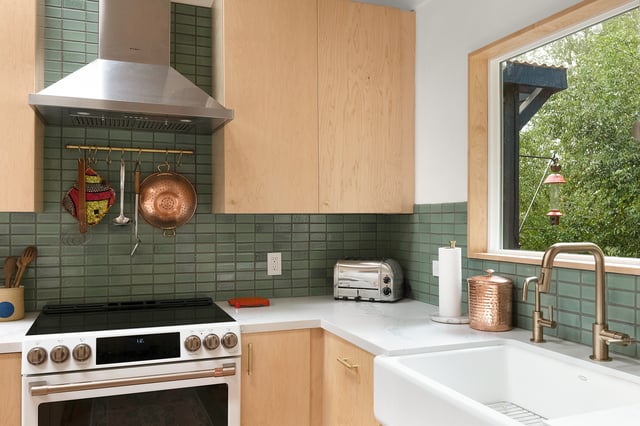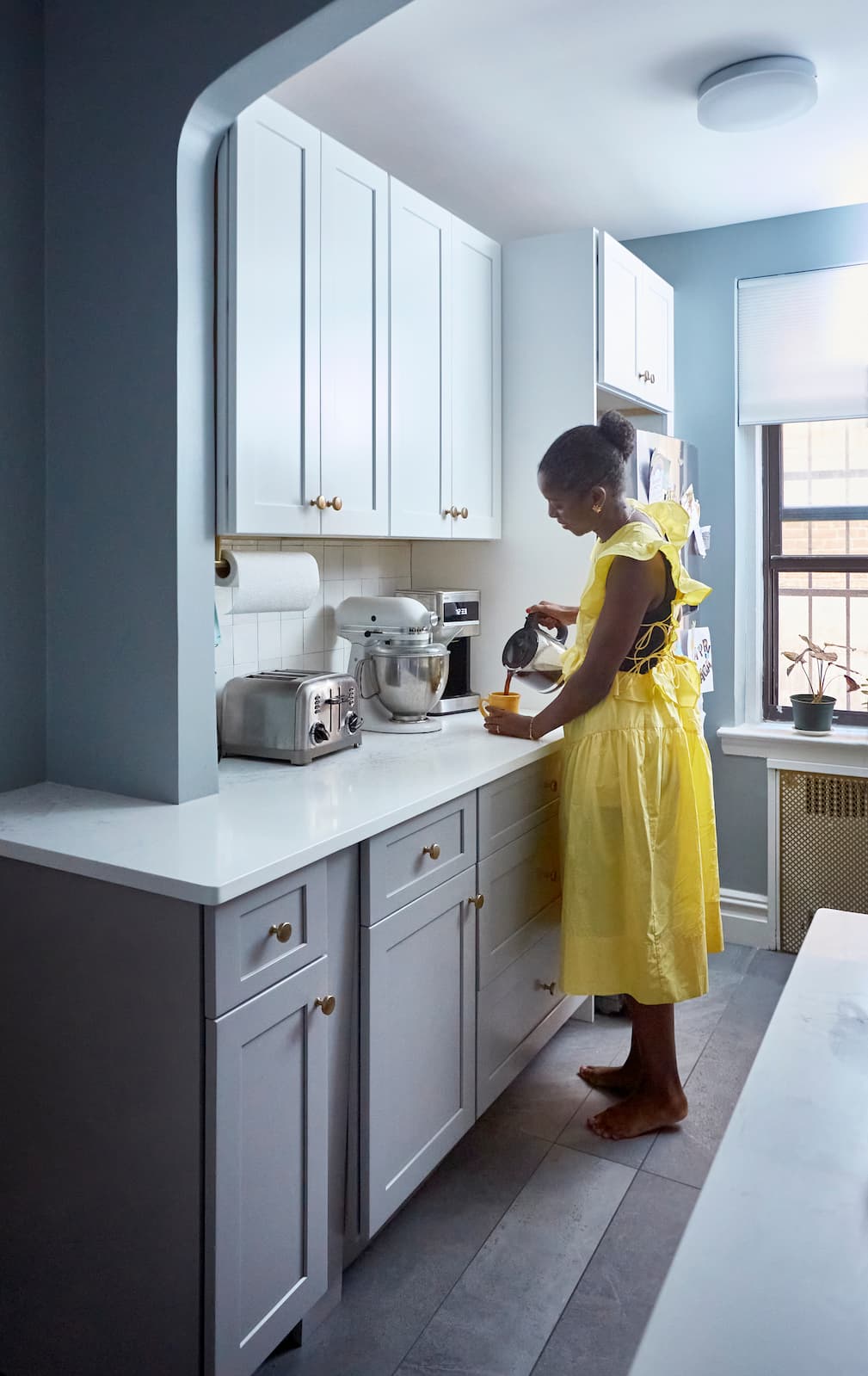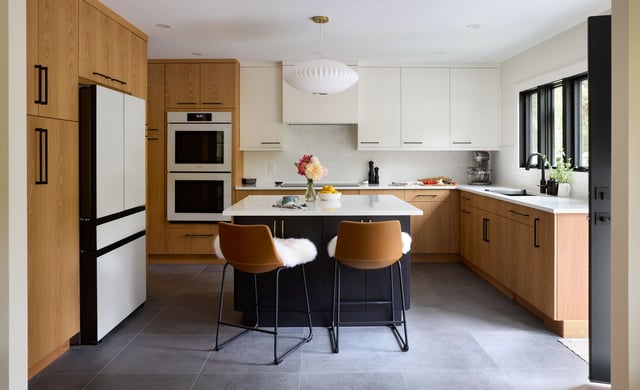
Kitchen
Non-Tile Kitchen Backsplashes - Alternative Ideas
12.06.2025


In This Article
So, you’ve decided to remodel your kitchen. Congratulations! You’re just a few decisions (okay, hundreds of decisions) away from the space of your dreams. But before you start knocking down walls or impulse-buying a marble slab the size of a minivan, let’s talk planning. Because the secret to a successful kitchen remodel isn’t just about good taste—it’s about good planning.
In this guide, we’ll walk you through everything you need to know before the dust starts flying, from setting a realistic budget to mapping out your ideal layout. We’ll also flag some of the most common planning mistakes—like forgetting where the fridge door opens or realizing too late that you do need more than one outlet.
Think of this as your friendly, no-nonsense roadmap to renovation success.
Design a Home That’s Uniquely Yours
Block can help you achieve your renovation goals and bring your dream remodel to life with price assurance and expert support.
Get Started
Before you pick out backsplash tiles or start swooning over quartz countertops on Instagram, take a deep breath—and get clear on why you’re remodeling in the first place. Are you sick of bumping elbows with your partner while making coffee? Is your oven from the Clinton administration? Or maybe your kitchen looks fine, but it just doesn’t work for how you live.
Start by listing out what’s bugging you. Is it the lack of prep space? The weird corner cabinets that require yoga-level flexibility to reach? Maybe your kitchen feels dark and dated, or you just want it to match your personal style (we see you, open shelving fans).
Think about functionality versus aesthetics. A gorgeous kitchen that doesn’t meet your needs will drive you nuts. So yes, dream big—but also dream smart. If you're constantly juggling pots because there’s nowhere to set them down, that butcher block island might be a better investment than a fancy pendant light.
Common kitchen pain points include awkward layouts, poor lighting, lack of counter space, and not enough outlets. (Seriously, why do they never put outlets where you actually need them?) Identifying these now will save you headaches—and probably money—later.
Your kitchen should fit your lifestyle, not the other way around. Do you host Sunday dinners for the extended family? Cook five nights a week? Or do most of your "meals" involve takeout containers and a microwave? There’s no wrong answer—but each one calls for a different design.
Family size matters, too. A two-person household has very different needs than one with three kids, a dog, and a rotating cast of friends. If you’ve got little ones, think about kid-friendly features like easy-access drawers and rounded corners.
And don’t forget about storage and layout. Are you a bulk-buying Costco type or a minimalist who lives off fresh produce? Do you want open shelves to show off your ceramic collection or cabinets to hide your mismatched mugs? Planning around how you live ensures your new kitchen isn’t just pretty—it’s actually useful.
Let’s talk about money—not the most glamorous part of remodeling, but definitely one of the most important. Your dream kitchen won’t build itself, and unless you’re sitting on a secret trust fund, you’ll need a plan to make those dreams come true without maxing out your credit cards.
Learn More: How to Plan Your Renovation Budget
First things first: know where your money is going. Cabinets tend to be the biggest chunk of the budget—think 30–40%. (Yes, those pretty doors add up fast.) Appliances usually take another 15–20%, and labor can easily account for another 20–30%. Then there’s flooring, lighting, countertops, and, of course, the mysterious “miscellaneous” category that somehow always grows.
The key is prioritizing. If you’ve always dreamed of a professional-grade range but don’t really cook, maybe scale back and spend more on cabinetry or lighting that makes the space feel good. You don’t have to splurge on everything—just the things that matter most to you.
Learn more: Kitchen Remodeling Cost Breakdown
Even with the most meticulous planning, surprises happen. Maybe your contractor opens a wall and discovers a pipe from 1952 that’s definitely not up to code. Or you fall in love with a tile that’s double the price of the one you originally chose. Welcome to the world of remodeling!
That’s why building a contingency fund is smart—typically 10–20% of your total budget. Think of it as your “just in case” cushion. Best case scenario, you don’t use it and can spend it on a fun splurge (hello, wine fridge). Worst case, you’re not blindsided by unexpected costs halfway through the project.
Also, keep in mind that design tweaks mid-project can get pricey. That “actually, I think I want an island” moment after the electrical’s been done? Not cheap. So, finalize as much as you can upfront and save yourself the stress (and extra invoices).
Setting a budget isn’t about limiting yourself—it’s about being smart with your money so your kitchen turns out fabulous and financially sound.
Renovate with confidence every step of the way
Step 1: Personalize Your Renovation Plan
Step 2: Receive Quotes from Trusted Contractors
Step 3: Let Us Handle the Project Details

Before you start choosing grout colors or arguing over matte versus glossy finishes, it’s time for the fun part: getting inspired. This is your chance to daydream, scroll, save, and screenshot to your heart’s content. Think of it as pre-remodel homework—but the kind where you're encouraged to binge Pinterest at midnight with a bowl of popcorn.
You probably already have a few ideas floating around (white oak cabinets? bold tile? secret coffee bar?), but now’s the time to dive in deep. Pinterest is a goldmine of ideas—just be prepared to fall down a rabbit hole that starts with “modern farmhouse” and ends with you wondering if you need a pot filler.
Instagram is another must. Search hashtags like #KitchenRemodel and #KitchenInspo, or get specific with styles like #ScandiKitchen or #DarkAcademiaKitchens (yes, it’s a thing). You’ll find real people’s remodels, which can be even more helpful than perfectly staged magazine shoots. Bonus: DM them to ask, “What paint color is that??” like a true kitchen sleuth.
Design blogs and websites (like Houzz, Apartment Therapy, and Remodelista) offer great visuals, but they also explain the why behind the design, which is helpful when deciding between open shelves or upper cabinets. And don’t underestimate the power of a good old-fashioned showroom visit. Seeing finishes and layouts IRL can give you a better sense of what you really like—and what your photos can’t capture (like how fingerprint-y that high-gloss cabinet gets).
Pro tip: Create a mood board—digital or physical—so you can start spotting patterns in what you love. Are you drawn to light and airy kitchens with natural wood? Sleek, minimalist kitchen designs with black fixtures? Making decisions later is easier when pointing to a clear style direction.
This step is like dating before marriage. Explore, flirt with a few trends, and see what sticks. Because when it comes time to commit, you’ll want to be really sure about that emerald green backsplash.
A mood board is your kitchen’s visual game plan. Use Pinterest, Canva, or even a Google Slides doc to collect images of colors, finishes, and layouts you love. Seeing everything together helps you spot patterns—and potential clashes—before you commit. It’s also super helpful when talking to contractors or designers. Instead of saying “cozy but modern-ish,” you can show them exactly what you mean. Plus, when decision fatigue hits mid-remodel, your mood board keeps you focused and true to your style. Think of it as your kitchen’s North Star—stylish, practical, and totally screenshot-worthy.
Now that you’ve got your inspiration and budget in place, it’s time to tackle one of the most important parts of your kitchen remodel: the layout. Because no matter how gorgeous your tile or how expensive your range, if your kitchen doesn’t flow, you’re going to end up muttering, “Who designed this?!” every time you try to unload the dishwasher.
Let’s start with the basics. Most kitchens fall into a few standard layout categories—and no, “chaotic and confusing” isn’t one of them.
L-shaped kitchens are great for open spaces and work well in smaller homes. They give you room to cook without feeling boxed in. Add an island, and boom: instant multitasking zone.
U-shaped kitchens offer loads of counter space and storage. You’re basically surrounded by kitchen goodness, which is perfect for serious cooks or people who just want to pretend they’re on a cooking show.
Galley kitchens (aka the hallway of culinary dreams) are efficient and perfect for small spaces—but they do require smart storage and good lighting to avoid the dreaded “kitchen cave” effect.
Open-concept kitchens are all about flow. They blend into your living or dining area, which is great for entertaining or keeping an eye on kids while cooking. Just be ready for everyone to see your dishes if you don’t clean up right away.
For more insights, read Great Kitchen Configurations: Ideas for Transforming Your Layout.
Once you’ve chosen your layout, it’s time to think about how your kitchen will function. Enter the work triangle. This classic design principle connects your stove, sink, and refrigerator in a triangle to make cooking more efficient and less of a workout.
You don’t want to be zigzagging around the kitchen just to boil pasta. A smart triangle keeps your prep, cooking, and cleaning zones within easy reach. Bonus points if no one gets trapped in a corner whenever the fridge opens.
At the end of the day, a good layout should make your life easier—and your kitchen feel like a place you actually want to be, not just a room where you reheat leftovers.
Unless you're planning to star in your own HGTV show, you’ll probably need some help bringing your dream kitchen to life. And while your cousin’s friend “who’s handy with a hammer” might offer a discount, remodeling is one of those times when you want the actual pros.
So, who does what? Let’s break it down.
Contractors are the people who make things happen. They handle the construction side—demo, plumbing, electrical, installation. If you already have a design plan, they’re your go-to. Pros: cost-effective and efficient. Cons: you’ll need to be the project manager unless you like playing phone tag between your cabinet guy and your tile installer.
Designers help with the visual and functional side—layouts, materials, finishes, lighting plans, and ensuring your kitchen doesn’t look like a rogue Pinterest board. Pros: they'll save you from decision fatigue and mismatched fixtures. Cons: they don’t manage construction, so you’ll still need a contractor.
Design-build firms do it all. They combine design and construction under one roof, which means fewer headaches, smoother communication, and one point of contact. Pros: streamlined process. Cons: it can be pricier—but sometimes, peace of mind is worth it.
Turn your renovation vision into reality
Get matched with trusted contractors and start your renovation today!
Find a Contractor
Before you sign on the dotted line (or Venmo someone a deposit—don’t do that), ask a few key questions.
The right team makes all the difference. With solid pros, you’ll stress less, stay on schedule, and maybe even enjoy the process—dust, delays, and all.
Learn More: How to Pick a General Contractor
This is the part where your kitchen starts to come to life—or at least look like the dream kitchen in your head. It’s also where your inner indecisive shopper might start sweating. So many choices! So many finishes! Don’t worry—we’re here to help you narrow it all down without losing your mind (or blowing your budget on one slab of imported stone).
Your cabinets are like the wardrobe of your kitchen. They take up the most visual space, so think about style and durability. Shaker-style cabinets are a timeless fave, but don’t be afraid to explore colors or go bold with hardware. Just maybe test that matte black finish for fingerprints before you commit.
Countertops are another major player. Quartz is popular for its durability and low maintenance and pairs well with everything. Natural stones like marble are gorgeous but require more upkeep (and an emotional support sponge for every spill).
For flooring, you want something that can stand up to dropped pans, spilled pasta sauce, and the occasional dance party. Hardwood adds warmth, but luxury vinyl and tile are durable and easier on the wallet—plus, no one will know unless they’re crawling around your floor (which we do not recommend).
Appliances might not be the most exciting decision, but they are the workhorses of your kitchen. Think about what fits your space and your life. A double oven might be perfect if you host every holiday, but it is overkill if your idea of cooking is heating up Trader Joe’s meals.
Energy-efficient models can save you money in the long run and are kinder to the planet. Win-win. Also, consider placement: make sure your fridge opens correctly, your dishwasher isn’t blocking every cabinet, and you’re not walking a mile from the stove to the sink.
Fixtures (hello, faucets and lighting!) are like the jewelry of your kitchen. They may be small, but the right ones tie the whole look together. Go classic, go trendy—just make sure they make you happy every time you walk in.
This is the part of your kitchen remodel that doesn’t involve pretty tile samples or mood boards—but trust us, it’s just as important. Without the proper permits and a solid timeline, your dream kitchen could become a bureaucratic nightmare (and possibly involve a stern visit from your local inspector).
Short answer: probably. If you're just swapping out cabinet doors or updating your backsplash, you're in the clear. But the moment you touch anything electrical, plumbing-related, or structural—permits are likely required. That means things like moving a sink, installing new lighting, or removing a wall to open the space will need official approval.
Permits aren’t just a formality. They ensure your remodel meets safety codes and won’t result in scary surprises during a future home sale. Plus, skipping them can lead to fines, project delays, and possibly having to undo all your hard work. It's not exactly the backsplash drama you were hoping for.
The good news? Your contractor or design-build firm should handle most of this for you. Just make sure to ask upfront who’s responsible for securing permits—because assuming someone else did, it is the fastest route to remodel limbo.
Once your paperwork is in motion, it’s time to plan your project timeline. A full kitchen remodel typically takes 6–12 weeks once construction starts, but that doesn’t include the design and planning phase. So, if you were hoping for a new kitchen by Thanksgiving and it’s already October… maybe aim for Easter.
Your timeline should include everything from demo day to final inspection, with room for the inevitable delays (because, yes, the tile you love might be back ordered for three weeks).
Pro tip: Plan for a temporary kitchen set up somewhere else in your home. You’ll thank yourself when you're not eating dry cereal from a paper towel for dinner every night.
With secured permits and a realistic timeline, you’re officially in the home stretch—and one step closer to the kitchen of your dreams.
A solid kitchen remodel timeline includes key milestones like demolition, rough plumbing and electrical, cabinet installation, and final finishes—typically spanning 6 to 12 weeks. But factor in planning, design, and shipping delays before the clock even starts. Delays happen (hello, backordered tile), so build in a buffer and stay flexible. Communicate regularly with your contractor to keep things moving and avoid surprises. With a little patience, your dream kitchen will be worth the wait.
Learn More: An Ultimate Guide to Home Renovation Phases and Timelines
You’ve planned, picked, budgeted, and dreamed—now it’s time to roll up your sleeves and get your space ready for the real fun: construction. But before the hammers start swinging, there are a few things you can do to make the process smoother (and less chaotic).
Start by packing up your kitchen like you’re moving out. Label boxes clearly (trust us, you will want to find the coffee mugs), and use this as an excuse to finally toss those mismatched Tupperware lids. Wrap breakables carefully and store essentials where they’re easy to access.
Next, create a temporary kitchen setup. A folding table, microwave, toaster oven, and coffee maker in the dining room can do wonders. Stock up on disposable plates, or embrace your inner camping chef. Bonus points if you have a grill—hello, outdoor cooking adventure!
Good communication = less stress. Schedule quick daily check-ins with your contractor to go over progress, ask questions, and tackle any unexpected issues early. Even a 10-minute update can help avoid misunderstandings and keep the project moving forward.
You can also use a shared calendar or project management app to track milestones—demo day, cabinet delivery, inspection dates—so you know what’s coming next (and when to brace for dust).
With a little prep and solid communication, you’ll survive the construction phase with your sanity—and sense of humor—mostly intact.
Your kitchen is finally taking shape—but don’t disappear just yet! Staying involved during the remodel helps ensure everything turns out how you envisioned (without turning you into that client).
Pop in for site visits, ask for updates, and be available to make decisions when needed—like choosing grout color or approving a last-minute lighting swap. Just resist the urge to hover. Trust your team, keep communication open, and let the pros do their thing. Think of yourself as the coach, not the quarterback.
Even the best-planned remodels hit a bump or two. Maybe the flooring delivery gets delayed, or a pipe surprises everyone during the demo. Stay calm, be flexible, and work with your contractor on solutions. Most issues are fixable—it just might take a little creativity (and deep breathing).
The tools are packed up, the dust has settled, and you’re this close to cooking your first meal in your new space.
During the final walkthrough, check for anything that needs touching up—scratches, paint drips, loose hardware. Make a list (your contractor likely will, too), and don’t be afraid to speak up. This is your moment to get those last details just right.
Once everything’s signed off, give your kitchen a good clean (or better yet, hire someone to do it). Unpack strategically—organize drawers, stock your pantry, and make the space yours. Then light a candle, pour a drink, and celebrate. You’ve officially survived a kitchen remodel—cheers to many delicious memories ahead!
Planning a kitchen remodel might feel overwhelming, but breaking it down step by step makes it manageable—and even fun. From defining your goals to picking the perfect backsplash, every decision gets you closer to a space that truly works for you. Embrace the process, expect a few bumps, and don’t forget to celebrate the little wins along the way. Ready to get started? Your dream kitchen is just a plan (and a few paint samples) away.

Written by Block Renovation
How long does a typical kitchen remodel take from start to finish?
What is the average cost of a kitchen remodel in 2025?
Do I need a designer for a small kitchen renovation?
How do I remodel a kitchen while living in the home?
What are the biggest mistakes to avoid when planning a kitchen remodel?

Renovate confidently with Block
Easily compare quotes from top quality contractors, and get peace of mind with warranty & price protections.
Thousands of homeowners have renovated with Block

4.5 Stars (100+)

4.7 Stars (100+)

4.5 Stars (75+)

Kitchen
Non-Tile Kitchen Backsplashes - Alternative Ideas
12.06.2025

Kitchen
Perfecting Industrial Kitchen Design With Your Remodel
12.04.2025

Kitchen
Farmhouse Kitchen Remodel Ideas from Block
12.04.2025

Kitchen
Best Types of Lighting For Your Kitchen Design
12.04.2025

Kitchen
A Pound Ridge Kitchen Remodeled: From Dated to Modern
10.14.2025
Renovate confidently